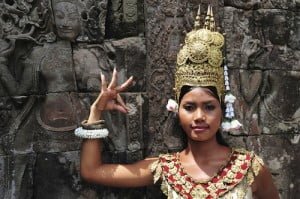New South Korean Road Protects Angkor Temples

Siem Reap, Cambodia – The Angkor World Heritage Site is fast becoming one of the most popular exotic tourist destinations in the world. And there lies the problem: too many tourists and too much traffic will damage the irreplaceable heritage of the Khmer civilization. The government of South Korea has just offered to help by funding a new road that will protect the temples from their own popularity. New South Korean Road Protects Angkor Temples
Between the 9th and 15th centuries the Khmer civilization flourished in northern Cambodia, ruling most of Southeast Asia and building hundreds of magnificent stone temples in the lush jungle. Most famous is the awe-inspiring Hindu temple of Angkor Wat, which has remained the largest religious monument in the world since Khmer King Suryavarman II built it in the 12th century.

Angkor Wat’s long corridors feature complex bas-relief carvings depicting stories of the creation of the universe, the royalty of the Khmers, and ancient legends based on Hindu epics. The temple also protects the largest collection of ancient female portraits in the world: more than 1,780 sacred Khmer women appear on the walls of Angkor Wat with fantastic costumes and accessories proving the Khmer’s cultural sophistication. And Angkor Wat is just one of hundreds of exquisite temples in the area.
In 1992, UNESCO declared the Angkor area a World Heritage Site, as well as including it on the World Heritage in Danger List to save it from further destruction. Tourism remains a vital part of Cambodia’s economy with nearly 1.5 million foreign tourists coming to admire the monuments each year, mostly from South Korea, Japan, China, Australia, Europe and the United States. More than half of these tourists visit Angkor but the impact of tourism has been felt.
The vast site is managed by the APSARA Authority, a Cambodian government body that is constantly working to improve tourist traffic and facilities while protecting their nation’s heritage. International organizations like the Global Heritage Fund, World Monument Fund, Friends of Khmer Culture and Heritage Watch International also contribute to the ongoing effort of keeping this important world history accessible.
The new South Korean grant will provide $9.2 million to Cambodia to build a road that will encircle the Angkor temple complex, thereby reducing traffic in the sensitive temple area. APSARA Authority Vice Secretary General Soeung Kong stated that the 21-kilometer road will be closed to trucks to reduce pollution, noise and vibrations that could damage the ancient ruins. Construction will begin in 2010 and is projected to take three years to complete.
This is the second Angkor area road funded by South Korea, according to South Korean Embassy official Son Sungil. The first road extended south from the temple complex.
Article by Kent Davis
